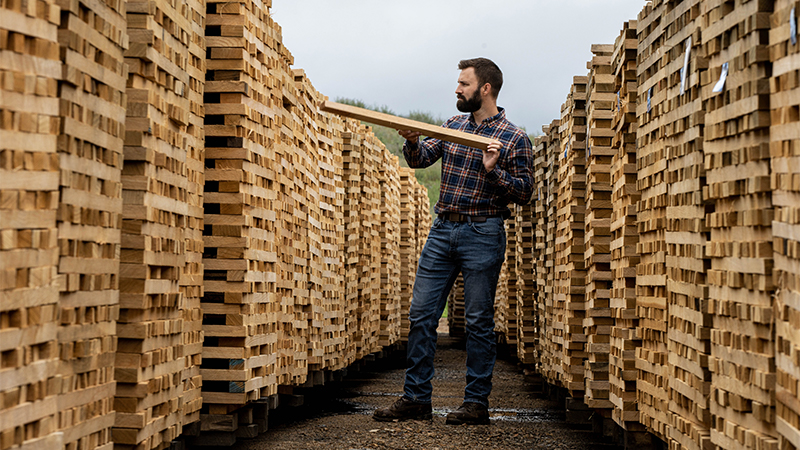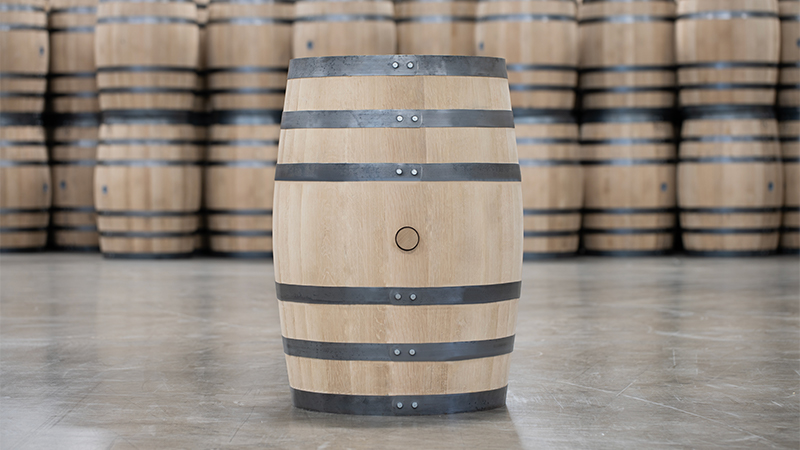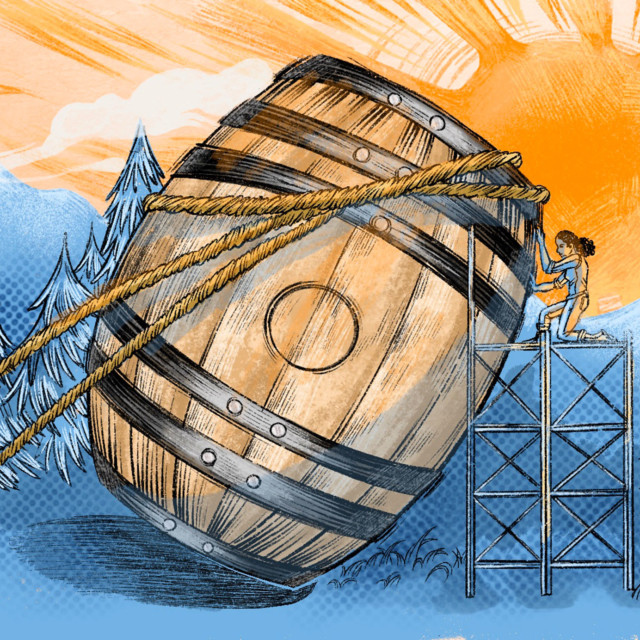All September on VinePair, we’re turning our focus to America’s spirit: bourbon. For our third annual Bourbon Month, we’re exploring the industry legends and innovators, our favorite craft distilleries, new bottles we love, and more.
On June 23, 2016, a foot of rain fell on the mountains surrounding White Sulphur Springs, W. Va., in just 12 hours. The water funneled through the long narrow valley in which the hamlet sits, transforming tiny Howard Creek into a wide, roiling torrent, toppling houses. One went up in flames — a floating bonfire careening through town. By the time the water receded, the flood had killed 13 people in Greenbrier County. Hundreds of residents had to relocate. The local economy, already depressed, was at risk of collapse. Tom Crabtree, an architect with a vacation home in town, surveyed the wreckage the next day. “I saw houses completely swept away — even the foundations were gone. One neighborhood had five fatalities. It was awful,” he says.
Six months later, Crabtree sat down for a Christmas dinner at the nearby Greenbrier Resort with fellow volunteers from Hope Village, a program to build new housing for flood victims. They happened to be seated next to a couple celebrating the fact that their company, the award-winning Smooth Ambler Spirits, had just been purchased by Pernod Ricard. Everything was great, Smooth Ambler co-owner Greg Parseghian told the table, but it was the height of the bourbon barrel shortage, and he was worried about finding enough barrels to keep up with production. Parseghian explained to Crabtree that he was frustrated watching local loggers cut perfect barrel wood — slow-growth American white oak — and ship it out of state to be made into barrels before he could buy them. “That clicked in our minds,” says Crabtree. “We all looked at each other because we had been looking for an economic development project.”
Just over three years later, Crabtree and his co-investors, some of whom had helped with rebuilding housing, opened the West Virginia Great Barrel Company (WVGBC), one of the most advanced cooperages in America. With a focus on digitally shaped staves, precise infrared wood toasting, and a number of other factors, WVGBC makes barrels with both distillers and the local economy in mind. Here’s a look at what sets it apart, and will hopefully make for better bourbon.
CUTTING-EDGE TECHNOLOGY
Crabtree and his team had no idea how to make a barrel, but that’s what consultants are for. After deep market research, they committed to a high-tech approach, both to be competitive and for maximum safety, which they felt was important to the community.
A barrel is made of 30 or so staves held together by steel hoops — there are no nails or glue. Small gaps between staves cause leakage, which distillers understandably hate. As a solution, WVGBC uses Computer Numerical Control (CNC) technology. In a nutshell, a computer looks at a plank, determines the widest stave it can get from it, then calculates the perfect sidewall angle for that width. The wider the stave, the more acute the sidewall angle has to be to seamlessly form the inside of the barrel. The CNC then creates coordinates for an automated cutter, which sculpts the stave. In the end, the more precise the sidewall angle, the less leakage, the happier the distiller.

ROBOTICS: FROM THE CAR INDUSTRY TO THE COOPERAGE
Bending, toasting, and charring is tough on wood, let alone humans who might get in the way. One of the most dangerous phases of the process is the Windlass press, which takes an uncompressed barrel — they look like huge flowers, splayed open at the top — and presses it into shape, holding it together with temporary hoops. “The wood is under tremendous pressure to spring outwards,” says Brett Wolfington, WVGBC’s general manager — certainly enough to send someone to the hospital.
Crabtree worked with industrial design firms with experience in the automotive industry to create a Windlass press that is completely robotic, so no workers have to handle barrels during that phase. Additional robotics move the cumbersome barrels, which weigh approximately 110 pounds, where they need to be, reducing chances of injury.
INFRARED TOASTING: IT’S ALL ABOUT CONTROL
Toasting isn’t entirely new in barrel making. Traditionally, barrels get a bit of a toast when coopers heat the wood so as to bend it (charring happens later, and is more about filtering impurities than gaining flavors). But intentional, flavor-focused toasting is relatively new. With the secrecy of the industry, it’s difficult to say who started what, but Crabtree gives a nod to Brown-Forman, home to brands such as Jack Daniel’s, Old Forester, and Woodford Reserve. “Brown-Forman has been wonderful,” he says. “They’ve opened their doors to us, they’ve given us support. We’ve toured their facility … but they wouldn’t let us see their toasting room,” he says with a chuckle.
Instead of toasting with a live flame, VWGBC uses steam to bend the wood, then toasts with an electric infrared heating process, which allows it to precisely control not only the temperature, but also the wavelengths of radiation. Shorter or longer wavelengths penetrate the stave to a certain depth, something distillers are more and more interested in.
“Driving heat into the wood in a controlled manner helps bring some of the sugars in that wood to the inner surface of the barrel and caramelize them,” says Wolfington. “They convert into the compounds that really give you bourbon.” The deeper you go, in theory, the more flavor you can access.
This can be an advantage to startup craft distillers who need to get their goods into the market faster, and Wolfington says he’s seeing a trend of stronger toasting and lighter charring, as charring can act as a barrier between the distillate and the flavors deeper in the wood.

APPALACHIAN OAK
WVGBC has one advantage that’s actually low-tech: Appalachian trees. “It’s hard to be a tree in West Virginia,” says Smooth Ambler operations manager Travis Hammond. Winters are vicious, the mountains are rocky with poor soil. The ways American white oaks adapt, though, makes for better bourbon. “The sugars contained within that wood are a little more dense,” says Hammond. “For lack of a better word, the tree knows that it’s going to potentially have a hard winter, so it has to hold on to those sugars.”
Tough conditions also make for slower growth and tighter age rings, which translate to more flavor. “In a given inch of wood, there’s more chemicals that can convert into the flavoring elements,” Wolfington adds.
WHISKEY AND THE TOWN
It’s still too early to taste whiskey that’s been fully aged in WV Great Barrel Company barrels, but this month, Smooth Ambler is releasing a product aged in other barrels, then finished in toast-only barrels from WVGBC. As for the newer Smooth Ambler sitting in WVGBC barrels, Hammond says he’s checked on the juice they started aging back in spring of 2020. “It’s coming along pretty good,” he says. “From all of our organoleptic analysis we’re thinking that their barrels are doing exactly what they need to do. And they have extremely low leak rates.”
Crabtree and Wolfington know there are other cooperages using CNC and infrared toasting, but WVGBC seems to be the only one combining the two. “You know, a lot of the industry is tradition-based, and people are going to buy barrels from where they’ve been buying them for 100 years,” says Crabtree, “but we’re changing the industry a little bit.”
Perhaps more important is the impact on the town. At the moment, White Sulphur Springs has a population of around 3,000 people. WVGBC’s sawmill employs about 75 people, the cooperage employs another 75, and Crabtree says they’ll be adding a second shift in the near future. And though the loggers don’t work for them directly, they’ve added jobs in that sector as well.
“The cooperage is a rock star,” says Crabtree. “Main Street was a ghost town 15 years ago. Today, virtually every building has a new business.” He attributes the growth to the momentum that started with the flood recovery efforts and carried through to the cooperage. “The barrel probably gets more credit than it deserves,” he says. “But it’s the momentum. Now Main Street is a juggernaut.”
This story is a part of VP Pro, our free platform and newsletter for drinks industry professionals, covering wine, beer, liquor, and beyond. Sign up for VP Pro now!
